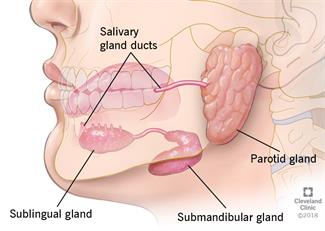Sialadenitis refers to a swollen salivary gland. It’s caused by infections, autoimmune diseases and salivary gland stones. When a salivary gland becomes inflamed, it can stop functioning. Sialadenitis usually goes away in about a week. But if you develop severe symptoms, such as difficulty breathing or swallowing, call 911.
Advertisement
Cleveland Clinic is a non-profit academic medical center. Advertising on our site helps support our mission. We do not endorse non-Cleveland Clinic products or services. Policy

“Sialadenitis” is the medical term for inflammation of one or more of your salivary glands. Salivary glands are the glands that make your saliva (spit). Saliva helps you swallow, digest food and protects your teeth from harmful bacteria. There are three major salivary glands:
Advertisement
Cleveland Clinic is a non-profit academic medical center. Advertising on our site helps support our mission. We do not endorse non-Cleveland Clinic products or services. Policy
In addition to your major salivary glands, you have hundreds of minor salivary glands. These smaller glands are in your lips, inner cheeks and all throughout the linings of your mouth and throat.
Sialadenitis mostly affects your parotid and submandibular glands.
It can be an acute (sudden), chronic (long-term), or recurrent (returning) condition. Sialadenitis is rare.
Anyone can get sialadenitis. But it’s most common among adults older than 50, especially those who have salivary gland stones.
Sialadenitis can also occur in other age groups, including:
Without proper treatment, sialadenitis can spread into the deep tissues of your head and neck, causing a severe infection. It’s important to see a healthcare provider right away if you have any sialadenitis symptoms, such as pain, swelling and fever.
Advertisement
Symptoms of sialadenitis include:
If you notice any of these symptoms, see a healthcare provider right away.
Sialadenitis causes include:
It depends on the cause. If sialadenitis is the result of an infection, then you can spread the infection to others through sneezing, coughing or coming into contact with infected saliva.
If a salivary gland stone caused sialadenitis, then there’s no risk of passing the condition on to someone else.
A healthcare provider will diagnose sialadenitis through a physical examination and a history of your symptoms. They may also examine your salivary glands with an endoscope (a tiny camera with a light attached).
Your healthcare provider might use a salivary gland scan to find blockages. They’ll use ultrasound or computed tomography (CT) scans for this test.
In some cases, your provider might refer you to an otolaryngologist (ENT) for further evaluation. An ENT is a provider who specializes in diagnosing and treating ear, nose and throat conditions.
There are several ways to manage sialadenitis, including:
Treatment depends on the severity of your condition.
Antibiotics are usually the first line of sialadenitis treatment. The most common antibiotics for sialadenitis include dicloxacillin, cephalosporin or clindamycin.
Your healthcare provide may also recommend home remedies to help decrease pain and increase saliva flow, including:
In some cases, your healthcare provider may deliver intravenous (IV) medications through a vein in your arm. They’ll give you saline or dextrose solutions to keep you hydrated and antibiotics to fight infection.
If sialadenitis doesn’t respond to other treatments, your healthcare provider may recommend surgery. If you’ve developed an abscess (a pocket of pus), they’ll drain the infection and remove any stones or other blockages. They may also use an endoscope to examine your salivary gland. Healthcare providers call this procedure a sialendoscopy.
Advertisement
In most cases, salivary gland infections resolve after one week with conservative treatment.
If you had surgery, it could take about two weeks to fully recover.
Infected or swollen salivary glands often go away on their own or with conservative treatment. But if you have lingering symptoms, such as swelling, pain, fever or difficulty swallowing, call your healthcare provider right away. You may need emergency treatment.
Generally, people with sialadenitis feel better in about one week with conservative treatment. If you need surgery, it could take two weeks for swelling and bruising to subside.
Sialadenitis can recur (return) in some people. While you can’t always prevent recurrence, you can reduce your risk by practicing good oral hygiene, staying hydrated and avoiding smoking.
Left untreated, a salivary gland infection can spread to the tissues of your head and neck. This is a life-threatening event. If you have difficulty breathing or swallowing, call 911 (or your local emergency number) or go to the emergency room immediately.
You may not be able to prevent sialadenitis completely. But there are a few things you can do to reduce your risk:
Advertisement
If you have lingering sialadenitis symptoms, such as facial swelling and fever that lasts for more than three days, schedule an appointment with your healthcare provider. They can find out what caused your swollen salivary gland and recommend appropriate treatment.
If you develop severe sialadenitis symptoms — such as difficulty breathing or swallowing — call 911 (or your local emergency number) or go to the nearest emergency room. You may need emergency treatment to avoid life-threatening complications.
Sialadenitis refers to inflammation of one or more of your salivary glands. It usually gets better in about a week with conservative treatments. But if your symptoms linger, or if you have trouble breathing or swallowing, you should seek emergency medical care right away.
Advertisement
Cleveland Clinic’s primary care providers offer lifelong medical care. From sinus infections and high blood pressure to preventive screening, we’re here for you.

Last reviewed on 08/29/2022.
Learn more about the Health Library and our editorial process.